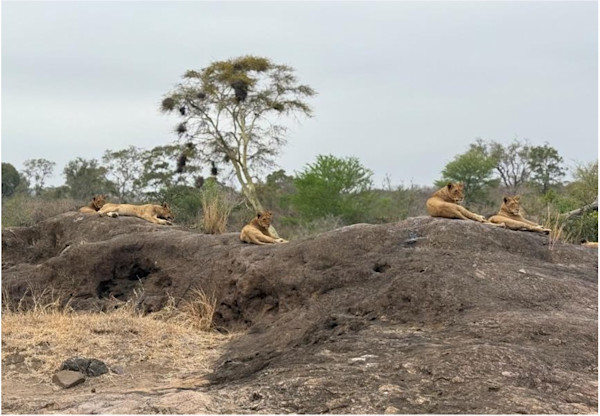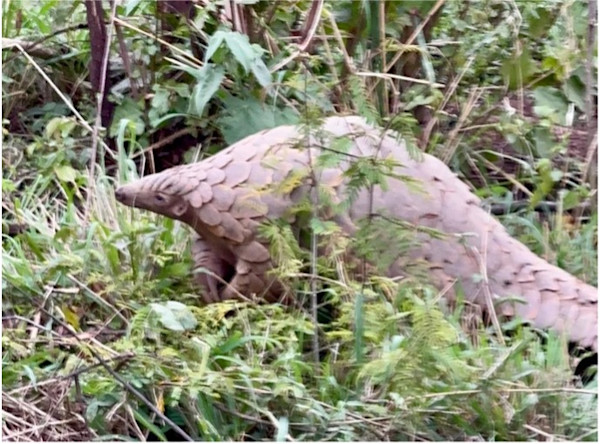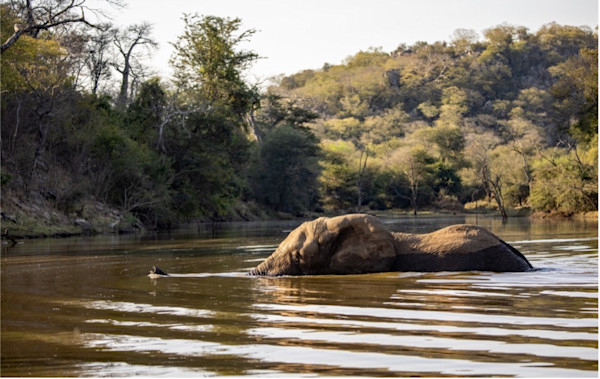November 2024
Biodiversity
A whole lot of bullfrog
in BiodiversityShare:
A whole lot of bullfrog

In all seriousness this was my most memorable sighting of November. Never mind mating lions or wild dogs hunting impala. I had been out driving in the morning after intense rainfall during the night, and was sticking to the main roads to avoid the vulnerable muddy soil. I had pretty much decided it was time to head back to the lodge as it seemed everything had gone into hiding. I was a bit despondent and thought it was weather for ducks and frogs. I’ve never seen an edible bullfrog (Pyxicephalus edulis) before, but have always hoped to, and just as I was driving along the raised link road between the Banyini and the airstrip, where the rainwater had flooded the roadside ditch area, I saw a flash of bright yellow in the muddy water. Reversing to check what it was, possibly a snake, I raised my binos and realised it was a bullfrog climbing onto a protruding branch in the water. Several more surprises followed…
As I got my eye in I saw more big green and yellow heads with enormous eyes protruding from the shallow pan’s surface. These males are big - about 8 to 13 cm (3.1 – 5.1 in) in snout-to-vent length. Then an almighty fight broke out! Two bullfrogs were splashing and wrestling in the water, the victor getting the opponent in a headlock with his jaws clamped over his head! It turns out they have two tooth like structures in the lower jaw of their wide mouth, and these aggressive bouts often cause serious injuries – even death.
My loser swam off, and seemed a little glum, but I watched him anchor himself onto some branches, and gather his wits. A few minutes later I heard him calling – a beautiful resonating “whoop”, similar to a hyena’s call. He did this by inflating his body, raising his head and vocal sacs above the surface, and as he called he caused a rippling effect in the water. It was such a romantic and seductive mating call! Apparently the smaller female bullfrogs swim about freely between these gatherings of males, as the males woo and pursue them.

I scanned about to check on the winner, as it seemed he’d just swum off to some other sticks and was idly floating about there – but how wrong I was. He was in the midst of amplexus! (Amplexus – one of my favourite words, is the mating position of frogs and toads, in which the male clasps the female about the back.) The only reason I knew I’d caught them in the act was because every now and then I saw the female’s head emerge from the water, as she gulped some air, before the weighty male pushed her under again.
Well, I thought I’d seen it all now, but they had yet another surprise in store. It appeared that there were now black speckles surrounding them in the water, that hadn’t been there a moment before, and by zooming in I realised they were eggs. The male bullfrog’s clasp stimulates the release of eggs from the female. As they are released, the male fertilizes the eggs with his sperm. The spawn was drifting in the shallow water.
It’s incredible to know that these bullfrogs spend at least 10 months of the year in aestivation underground, only emerging to breed if sufficiently heavy rain, i.e. more than 70 mm (2.8 in), falls within a short period. Breeding activity happens quickly, only over a couple of days, and is prevalent during the early morning. I was in the right place, at the right time, to witness such a fleeting sighting.
I kept a close eye on that temporary pan over the next week, and two evenings later saw an owlet perched on a low branch over the shallows. It’s not impossible that this owlet was hunting frogs as it is known that these aggregations of breeding frogs attracts several bird predators, particularly storks and herons. The frogs themselves have a diet that includes a wide range of insects.
Exactly one week later I was driving past the same area, and much of the water had subsided, but I noticed dark patches and ripples along the edge of the pan. These turned out to be dense schools of edible bullfrog tadpoles. They swim in schools, at the edge of the water, to try and avoid predation and to gain better access to food. They were already well developed, and you could see those unmistakable beady eyes. Before long the magic of metamorphosis would cause their legs to grow, their tales to shrink, their lungs to develop, and all the other changes that transforms a tadpole into a frog.
As a closing to this story it appears there has been some misidentification between edible bullfrogs (Pyxicephalus edulis)and the closely related species of African bullfrogs (Pyxicephalus adspersus). Edible bullfrogs have a distinct tympanum, which is large and oval in shape. A frog's tympanum is a patch of skin behind the eye that functions similarly to a human eardrum. Pyxicephalus adspersus are much bigger than edible bullfrogs.
Regarding edible bullfrogs being edible, they are, but I heard from someone adventurous enough to try one that while it was edible it was far from delicious!



By Jenny Hishin
Author / Field Guide


